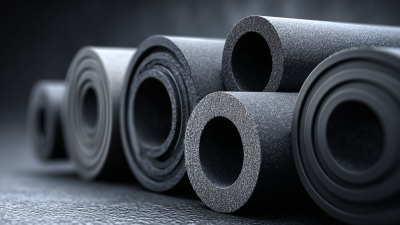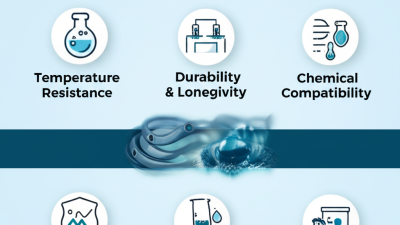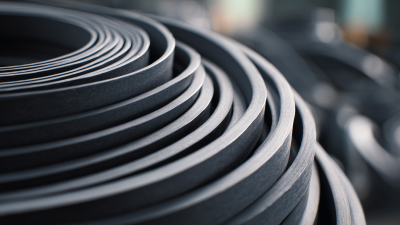Unlocking the Potential of Fluoroelastomer Copolymer: Transformative Applications in High-Temperature Industries
Table of Contents
- Exploring the Unique Properties of Fluoroelastomer Copolymers
- Key Industries Benefiting from High-Temperature Performance
- Tips for Selecting the Right Fluoroelastomer for Your Application
- Innovative Manufacturing Techniques for Fluoroelastomer Copolymers
- Future Trends and Developments in Fluoroelastomer Technology
- FAQS
- Conclusion
- Related Posts
You know, in the fast-moving world of high-temperature industries, there's never been a greater need for innovative materials that can really stand up to extreme conditions. That’s where Fluoroelastomer Copolymer comes into play — it’s honestly a game-changer, with the potential to set new performance standards across a bunch of different applications. Sichuan Fudi New Energy Co., Ltd., has been around since 1998, and we've been at the forefront of producing and marketing fluoroelastomer and other fluorinated rubber materials for over 20 years. Thanks to our deep experience, we’re able to deliver top-quality products, like fluoroelastomer base polymers, FKM/FPM precompounds, and even specialized curing agents. As industries keep pushing for better efficiency and longer-lasting solutions, Fluoroelastomer Copolymer really stands out as a key player in meeting those tough demands—while also helping drive innovation and sustainability in high-temperature scenarios.

Exploring the Unique Properties of Fluoroelastomer Copolymers
Fluoroelastomer copolymers are pretty amazing materials — they’re known for their unique traits that make them so valuable, especially in industries where things get super hot. Basically, they’re made from a mix of fluorinated and non-fluorinated monomers, which gives them awesome chemical resistance, stability, and durability. That means they can handle some seriously extreme conditions without breaking a sweat. What’s really cool is that they stay flexible and resilient even at high temperatures, which sets them apart from other elastomers. That’s why you’ll find them in stuff like aerospace, automotive, and chemical processing industries.
The reason these copolymers are so special boils down to their molecular structure. It gives them low surface energy and excellent thermal stability. In simple terms, they resist breaking down when exposed to harsh solvents, fuels, or crazy high heat. Plus, they’ve got great electrical insulating properties and can resist UV rays, making them perfect for high-tech applications. As industries keep pushing for better materials that can handle tougher conditions, fluoroelastomer copolymers are becoming more and more important, opening up all sorts of cool new possibilities for high-temperature uses.
Key Industries Benefiting from High-Temperature Performance
Fluoroelastomer copolymers are really starting to shake things up in industries that operate at super high temperatures — stuff like aerospace, automotive, and energy sectors. Why? Because they’re incredibly good at handling extreme heat and resisting chemicals, which means they can survive conditions that would basically break down other materials. Companies in these fields are looking more and more to fluoroelastomer copolymers to make their products last longer and perform better. It’s a smart move if you want to stay ahead in such a tough market.
If you're thinking about new materials for your projects, it’s worth considering the specific high-temperature needs you’re dealing with. These copolymers might just help cut down on maintenance costs and give your equipment a longer life. Plus, don’t forget to keep an eye on innovations popping up in related areas — like robotics — where lightweight and flexible materials can seriously boost performance.
As tech companies, especially those working on high-temperature superconductors, push forward with new developments, adding innovative materials into the mix becomes more and more important. Take lightweight materials and electronic skin components, for example — they’re playing a huge role in building the next generation of robots. By investing in fluoroelastomer copolymers now, businesses can stay ahead of the curve and be part of these exciting changes happening in high-temp industries.

Tips for Selecting the Right Fluoroelastomer for Your Application
So, when you're trying to pick the right fluoroelastomer for those high-temperature jobs, there are a bunch of important factors you really need to think about. I came across a report from Specialty Chemicals Market Insights that forecasts the fluoroelastomer market hitting around $2.4 billion by 2027. That’s mainly because industries like automotive and aerospace are really leaning on these materials more and more. They’re pretty amazing at resisting chemicals, handling extreme heat, and standing up to the test of time—perfect for tough environments.
But here’s the thing: choosing the right one isn’t just about grabbing the first thing that looks good. You’ve got to consider the thermal stability and whether it’s compatible with the chemicals it’ll meet in your application. For example, some formulations can handle continuous temps up to 250°C (482°F), while others aren’t quite as tough and are better suited for lower ranges. There’s also research from the American Society for Testing and Materials that points out how crucial it is to pick a fluoroelastomer that doesn’t swell too much in certain solvents—that’s key for keeping dimensions stable under harsh conditions. Plus, mixing fluoroelastomers with other elastomers can really boost their mechanical strength, which comes in handy if you’re making O-rings and seals for oil and gas stuff.
All in all, understanding exactly what your application needs—like what chemicals it’ll meet, the temperatures it has to endure, and the mechanical stresses involved—is what’s going to guide you to make smart choices. Getting this right means you can unlock the full potential of fluoroelastomers, leading to better performance, longer-lasting parts, and fewer headaches down the road where reliability is a must.
Unlocking the Potential of Fluoroelastomer Copolymer: Transformative Applications in High-Temperature Industries
Innovative Manufacturing Techniques for Fluoroelastomer Copolymers
You know, fluoroelastomer copolymers are really gaining recognition these days for how versatile and tough they are, especially in high-temp industries like aerospace, automotive, and chemical processing. It’s pretty clear that new manufacturing techniques are key to making these materials perform even better under extreme conditions. Just recently, advances in extrusion and molding have really helped manufacturers boost their thermal stability and resistance to chemicals. I came across a market report from Grand View Research back in 2022—it said that the global market for fluoroelastomers was worth around $2.05 billion in 2021, and it’s expected to grow at a rate of about 6.5% annually from 2022 through 2030. Most of this growth seems to come from the demand for high-performance seals in really tough environments.
What’s pretty exciting, though, is how additive manufacturing—like 3D printing—is opening up new doors for these materials. Now, companies can create complex shapes that just weren't possible with the old-school methods, which makes everything faster and more customizable to fit specific industrial needs. Imagine parts that can handle temperatures of up to 250°C—while staying flexible and durable—that’s a game-changer for industries all about innovation and efficiency. As the need for high-temp applications keeps evolving, I think we’ll see fluoroelastomer copolymers playing an even bigger role in tackling the tough demands of modern engineering.
Unlocking the Potential of Fluoroelastomer Copolymer: Transformative Applications in High-Temperature Industries - Innovative Manufacturing Techniques for Fluoroelastomer Copolymers
| Application Area | Temperature Resistance (°C) | Chemical Resistance | Processing Method | Typical Applications |
|---|---|---|---|---|
| Automotive Seals | -40 to 200 | Excellent | Compression Molding | Gaskets, O-rings |
| Industrial Equipment | -30 to 230 | Very Good | Extrusion | Hoses, Belts |
| Aerospace Components | -55 to 260 | Excellent | Injection Molding | Fuel Systems, Seals |
| Pharmaceutical Equipment | -10 to 250 | Good | Calendering | Pumps, Seals |
| Oil and Gas | -40 to 210 | Excellent | Blending | Seals, Linings |
Future Trends and Developments in Fluoroelastomer Technology
Hey, have you noticed how the fluoroelastomer market is really booming lately? It’s mostly because industries that deal with super high temperatures—like automotive and chemical processing—are turning to these materials more and more. I read somewhere that the global rubber O-ring market might hit around $6.5 billion by 2025. That’s a huge number, and a good chunk of it is made up of stuff like Perfluoroelastomer (FFKM) O-rings and Buna O-rings. FFKM, especially, has become quite the favorite because it can handle crazy heat and chemical exposure—things that regular elastomers just can't keep up with, you know?

The car industry is expected to play a big role in this growth, with an annual rate of about 5.4%. Car makers are on the lookout for materials that can survive the tough conditions cars face every day. Plus, the chemical and petrochemical sectors are also jumping on the bandwagon, using fluoroelastomers for seals and gaskets thanks to their impressive resilience against rough, aggressive substances. As tech keeps moving forward, they’re coming up with new formulas and better processing methods, which should make these materials perform even better and find their way into all sorts of new applications. It’s pretty exciting to see how this all evolves, right?
FAQS
: Fluoroelastomer copolymers are transformative materials known for their exceptional thermal stability and chemical resistance, primarily used in high-temperature industries such as aerospace, automotive, and energy.
High-temperature industries are interested in fluoroelastomer copolymers because they enhance durability and efficiency, allowing products to withstand extreme conditions and providing a competitive edge.
Fluoroelastomer copolymers can lead to lower maintenance costs and longer service life due to their resistance to extreme temperatures and chemicals.
The fluoroelastomer market is projected to experience significant growth, particularly in high-temperature industries like automotive and chemical processing, potentially reaching around $6.5 billion by 2025.
The automotive sector is expected to grow with a compound annual growth rate (CAGR) of 5.4%, driven by the demand for materials that can endure harsh environments.
In the chemical and petrochemical industries, fluoroelastomers are increasingly used for seals and gaskets due to their resilience against aggressive substances.
Ongoing technological advancements are leading to the development of new formulations and processing techniques, which are expected to enhance the performance characteristics of fluoroelastomers.
FFKM (Perfluoroelastomer) is known for its exceptional thermal stability and chemical resistance, making it essential in high-performance applications where traditional elastomers may fail.
Fluoroelastomers, particularly lightweight materials and flexible components, are likely to significantly impact the performance of next-generation robots as companies advance their technologies.
Companies should assess the specific high-temperature demands of their applications and consider fluoroelastomer copolymers as a solution that may enhance durability and efficiency.
Conclusion
So, Fluoroelastomer Copolymer is really a game-changer when it comes to materials that can handle extreme temperatures. It’s incredibly useful in industries like aerospace, automotive, and chemical processing where heat and tough conditions are daily challenges. What makes these copolymers stand out are their awesome properties—like excellent thermal stability, great chemical resistance, and a good deal of flexibility. All of this really helps improve the performance and reliability of parts that are constantly pushed to their limits.
Here at Sichuan Fudi New Energy Co., Ltd., we’ve been focusing on the production and sale of fluoroelastomers and fluorinated rubber materials for over 20 years now. Thanks to our experience, we’re pretty good at helping our customers pick out the right Fluoroelastomer Copolymer for what they need. We’re always innovating with new manufacturing techniques, and our ongoing research keeps us ahead of the curve. That way, we can keep offering cutting-edge solutions that meet the changing demands of industries obsessed with high-performance materials.
Related Posts
-

How to Choose the Right Viton Material for Your Industrial Needs
-

Exploring Industry Trends for Viton Hose at the 2025 China 138th Canton Fair
-

What is Viton Rubber Material and Why It is Essential in Industrial Applications
-

Top Strategies for Boosting Efficiency with Material Fkm Viton in Industrial Applications
-

7 Best Practices for Working with Fluorocarbon Rubber in Industrial Applications
-

Understanding the Performance Advantages of Fluoroelastomer Copolymer in High Temperature Applications
Blog Tags:

Charlotte
-

Phone
-

E-mail
-

Whatsapp
-

Top



